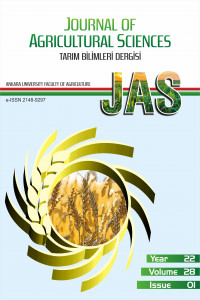Abstract
References
- Aydı B & Barbas L A L (2020). Sedative and anesthetic properties of essential oils and their active compounds in fish: A review. Aquaculture 520: 734999. https://doi.org/10.1016/j.aquaculture.2020.734999
- Bayramzadeh N, Mehrkhou F, Pourmirza A A & Mahmoudian M (2019). Fumigant Toxicity of Two Nano-Capsulated Essential Oils with Sublethal Rate of Phosphine against Three Stored-Product Pests. Journal of Agricultural Science and Technology 21(4): 857-872.
Effects of Normal and Nano-Capsulated Thyme and Peppermint Essential Oils on Intestinal Morphology and Microbial Population of Broilers Fed on Standard and Low Crude Protein Diets
Abstract
This study was conducted to investigate the effects of normal and nano-capsulated forms of thyme and peppermint essential oils on intestinal morphology and microbial population of broilers fed on normal and low crude protein diets. The study was carried out with a total of 320 Ross-308 broiler chickens as a 2×2×2 (2 medicinal plant essential oils, 2 forms of oils and 2 levels of diet crude protein) factorial arrangements with 32 groups (10 chicks per replicate) according to a completely random design. This experiment was done in three periods included: Starter (1-10 days), grower (11-24 days) and finisher (25-42 days). The experimental diets had significant effects on intestinal morphology (P<0.05), so that the use of the usual form of essential oils while reducing the depth of the crypt, increased the ratio of the length of the villa to the depth of the crypt. In use of peppermint essential oil with standard protein, crypt depth increased, and the ratio of villi height to crypt depth was minimal (P<0.05). A decrease in dietary crude protein level reduced the population of lactobacilli in the intestine (P<0.05). However, the level of crude protein in the diet and the form of use of the essential oil, as well as the type of essential oil and its form, did not have significant effects on the intestinal microbial population (P>0.05). Based on the results of this experiment, it can be stated that in broilers, the use of the encapsulated form of thyme essential oil in diets with standard crude protein levels, improved the intestinal morphology and intestinal non-pathogenic microbial population of broilers. Ten percent reduction in dietary crude protein level had adverse effects on measured traits and is not recommended, and in case of reduction of dietary protein, it is necessary to use peppermint essential oils supplements.
Keywords
Crude protein levels Essential oil Intestinal morphology Microbial population Nano-capsulation
References
- Aydı B & Barbas L A L (2020). Sedative and anesthetic properties of essential oils and their active compounds in fish: A review. Aquaculture 520: 734999. https://doi.org/10.1016/j.aquaculture.2020.734999
- Bayramzadeh N, Mehrkhou F, Pourmirza A A & Mahmoudian M (2019). Fumigant Toxicity of Two Nano-Capsulated Essential Oils with Sublethal Rate of Phosphine against Three Stored-Product Pests. Journal of Agricultural Science and Technology 21(4): 857-872.
Details
| Primary Language | English |
|---|---|
| Journal Section | Makaleler |
| Authors | |
| Publication Date | February 25, 2022 |
| Submission Date | June 25, 2020 |
| Acceptance Date | August 3, 2020 |
| Published in Issue | Year 2022 Volume: 28 Issue: 1 |
Cite
Journal of Agricultural Sciences is published open access journal. All articles are published under the terms of the Creative Commons Attribution License (CC BY).


